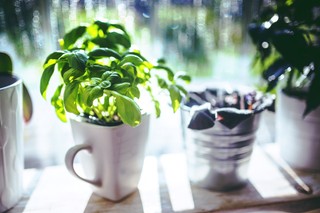Your guide to the best indoor lighting for growing herbs

Lighting is one of the most critical aspects of growing herbs or microgreens indoors, yet its importance is often overlooked by homeowners. Growing plants indoors presents challenges in providing the correct amount of light to the plants, much more so than outdoor gardens where sunlight is more prevalent. If not enough light is available for plants they will falter and growth is poorly affected; too much light can cause damage to foliage, creating undue stress on your plants.
To give your indoor plants or your indoor herb garden the right amount of light it’s beneficial to understand why light source and light exposure are important, the types of light available in your home, your plant’s light requirements, the symptoms of under or overexposure, and how to combat improper light levels.
Why is light important to your plants?
At a very basic level, all living organisms rely upon the sun as a source of energy. Plants use their leaf surface as solar panels to collect energy from sunlight. This stored energy is then used to drive photosynthesis, a chemical process powered by light that takes water and carbon dioxide and produces glucose plants use for food and the oxygen found in the atmosphere. Higher organisms don’t absorb energy from light directly but consume green plants or other organisms that subsist on plants as an energy source, deriving their energy from the foods they consume.
Light displays different properties and has different impacts on plants and their growth based upon its wavelength. Wavelengths of blue light and red light are the two most relevant to plants facilitating foliage growth and flowering. Plant growth and yield are optimized when plants are exposed to a combination of the two wavelengths, surpassing values observed when there is exposure to either wavelength separately.[1]
Sunlight is an ideal source of natural light for plants as it gives off varying amounts of all wavelengths of visible light, promoting good plant growth.
- Ultraviolet light (100 nm to 380 - 400 nm) was thought to be completely dangerous and unnecessary for plant growth for the longest time due to the damage it causes to the DNA, lipids, and proteins of living organisms. It was found though that exposure to damaging UV-light has some benefits to aromatic herbs. To protect leaves from UV-radiation, herbs increase essential oil production to create a reflective barrier between the surface and the UV light exposure.
- Violet light (380 nm to 445 nm) works to improve the color, taste, and aroma of herbs and microgreens. It also allows antioxidants to perform more efficiently, reducing cellular damage.
- Blue light (450 nm to 495 nm) is one of the two most important visible wavelengths for plant growth, and the wavelength found in the highest proportion of sunlight. Visible blue light supports chlorophyll formation, allowing plants to absorb energy from the sun, stimulating healthy foliage growth.
- Green light (495 nm to 570 nm) isn’t absorbed much by plants but is instead reflected back causing plants to appear as shades of green.
- Yellow light (570 nm to 590 nm) acts similarly to green and has little to no effect on plant growth.
- Red light (620 nm to 720 nm**)** is the other wavelength critical in plant growth; it induces the development of buds and their subsequent flowering.
How do windows affect the light reaching plants?
Window glass does affect the type and amount of light hitting your plants, depending on the windows you have installed in your home, but the effects are typically minimal. Uncoated glass windows allow the entire spectrum of visible light through while low emissivity (low-E) windows block some of the UV light.
Regardless if the glass is coated or not, some of the wavelengths are scattered as they pass through the window, reducing the amount that hits your plants: single-pane uncoated glass lets in about 90% of the visible light rays; double-pane uncoated allow about 81%; low-E (low emissivity) let’s in about 75 to 78%. While the low-E windows let in less light, some homeowners claim their plants grow better under the low-E conditions because of the thermal protection they offer, buffering temperature variations.

The enthusiast's guide to herbs
We’re proud to present our new e-book, The Enthusiast’s Guide to Herbs! Learn everything you need to know about growing and caring for herbs indoors, including in-depth info cards for the 35 most commonly grown herbs.
Click the link below to find out more!
Different types of light indoors
There are three different types of light your plants are exposed to when grown indoors: direct and indirect sunlight, and artificial light. This is where the biggest difference lies between outdoor and indoor plants, as outdoor plants primarily receive natural light, or direct sunlight.
Direct light comes through south windows all day long and west-facing windows during the middle part of the day. This natural light is bright and sunlight falls directly on the foliage. For many houseplants, this light is too intense, but herbs and microgreens typically withstand the direct light.
Indirect light is bright light without direct sunlight, usually found as you move away from the rays streaming in through the windows. Most houseplants prefer bright, indirect light when grown indoors.
Artificial light is given off by the lamps and overhead fixtures found in your home. Home lighting in the past typically used incandescent bulbs, giving off little light usable by plants. With the advent of compact fluorescent lamps, and LED grow lights plants may receive some light from them depending on the spectrum they emit, but most times it isn’t sufficient for growth.
Understanding a plant’s light requirements
Now that you understand the type of wavelengths your plants need and consider the light they are receiving within your home, it’s critical to gauge if their needs are appropriately being met.
The hours of light a plant needs depends on the individual plant; flowering plants typically require more light – red light especially – than foliage plants.
Light amount and intensity
In terms of the light intensity, plants are classified as needing full sun, partial sun, partial shade, or full shade locations. These classifications are based upon the duration of sunlight needed throughout the day. Originally they were developed for outside plants but act as a guideline for indoor plants too.
Full sun plants require a spot receiving six or more hours of direct sunlight each day. The light exposure doesn’t have to be continuous but can be broken up throughout the day as long as the total exposure is greater than six hours. Many herbs are classified as full sun: rosemary, lemongrass, sage, marjoram, oregano, and most microgreens. South windows are the best spot for full sun plants.
Partial sun and partial shade requirements are fairly interchangeable and mean a spot receives between four and six hours of direct sun over the course of the day. Partial sun plants prefer sunlight amounts as close to the six hours as possible; partial shade plants prefer spots that receive less light, while still hitting the minimum threshold of four hours. East or west-facing windows are great locations for partial sun or partial shade plants like catnip, chamomile, dill, and fennel.
Full shade plants want less than four hours of direct sunlight a day. They thrive with filtered sunlight or some direct sun in the early morning. North facing windows are appropriate locations for the following plants preferring full shade: mint, parsley, cilantro, thyme, chives, and lemon balm.

LED lights vs Compact fluorescent grow lights
When it comes to lighting, everyone’s situation is going to be unique. Some very lucky home gardeners are able to grow herbs indoors with only natural lighting. For the rest of us, we turn to the use of artificial lights and the question of what type of lighting is needed for your indoor herb garden.
When it comes to the comparison of led lights vs compact fluorescent grow lights it really just depends on your budget and how much lighting you need. Herb gardening indoors can be as big or small of an undertaking as you want it to be.
Generally speaking, led lights tend to be more expensive, but also more efficient and durable. Compact fluorescent grow lights are cheaper than most led lights, but also are more fragile, and by their very nature, more dangerous. These lights are tubes that fill with a gas that illuminates, and if the tube breaks, that can be harmful. This alone isn’t a dealbreaker for me, but it’s something that should be kept in mind when deciding what type of light is best for you.
Here are some of our favorite lighting products.
Micro Grow Light Garden
The Micro Grow Light Garden is our favorite go-to lighting system for home gardeners. This product provides everything you need in terms of lighting for your indoor herb garden. It measures in at just under 22" long by just under 8" wide, and provides a functional location for you to grow your favorite indoor herbs, plants or microgreens.
This unit comes equipped with a polypropylene plastic, high impact polystyrene, aluminium, T5 fluorescent light bulb. The flat planting tray holds 2 quarts of your favorite soil or growing media, and the water reservoir holds 3 quarts of water making dry soil a thing of the past. The Micro Grow Light Garden is functional, practical and gives you the opportunity to grow and add additional lights as needed.
Pros:
- High-quality design
- 3 quart water reservoir
- Planting tray that can hold 2 quarts of soil
- T5 fluorescent growing light bulb comes standard
Clamping Light Fixture
This is a great product for small indoor herb gardens, or as an individual light for one plant. The clamp design makes it extremely flexible, and a great option for those with limited space.
This clamp light from Gardeners Supply Company is a good starting point.
Pros:
- Flexible and practical
- Being able to pick your own bulb
- Great for individual potted plants
Cons:
- No bulb included
- Short light range
Symptoms of under and overexposure
To gauge if your plants aren’t getting enough light, or are getting too much light it’s best to watch for the following indicative symptoms.
Too little light:
- Plants get leggy – i.e. tall and spindly – as they try to reach towards the available light.
- Variegated plants lose leaf variegation, turning solid green.[2]
- Slow or no growth from the reduced photosynthesis rates.
- New leaves are small or stunted in growth compared to older foliage.
Too much light:
- Leaves appear sunbleached. Too much light damages the photosynthesis process and creates reactive oxygen species that cause free radical damage to plant tissues and chlorophyll.
- Scorched patches appear on the leaves, especially those on the upper part of the plant.
- Plants wilt at midday when the sun’s intensity is the strongest, regardless of the soil moisture content.
- Leaves become brittle, dry down, and may die back if the overexposure is too great.
How to combat unsuitable light conditions
If your plants aren’t getting the correct amount of light, and you see signs of underexposure or overexposure, you need to make some adjustments.
Overexposure is seen less often indoors and is easily corrected by moving plants to a less sunny location. Sometimes this is as simple as moving them off of a windowsill, putting them slightly further away and out of the sunlight’s direct rays.
More often than not, most homes struggle with not having enough light for indoor plants versus having overexposure of sunlight. This presents challenges to growing herbs or microgreens but can be overcome.
If your home has low light conditions, and you still want to try to grow herbs or microgreens you can increase your chances of success by implementing the following strategies:
- Maintain optimal growing conditions in terms of ambient temperature, relative humidity, proper watering and fertilizing. While this doesn’t fix low light conditions it helps the plant sustain conditions that aren’t optimal.
- Provide supplemental lighting via grow lights to compensate for low light levels within your home. Metal halide and high-pressure sodium are the best lamps to use in combination; metal halide lamps supply blue wavelengths and high-pressure sodium give off an orange-red light. Make sure to keep them a safe distance away from plants because of the heat emitted. Fluorescent, compact fluorescent, and LED’s are also good choices to use. They are available in a wide range of light spectrums, emitting various wavelengths. LED fixtures can be developed specifically for plant growth applications, giving off 75 to 85 percent of its wavelengths in the red region of the light spectrum.
- Choose to grow plants with lower light requirements such as those listed above that do well in full shade locations.
Conclusion
Providing indoor herbs and microgreens with the correct amount of light is key to proper growth. Energy from sunlight is used to power photosynthesis and produce food to fuel plant growth; not enough light will slow or halt growth completely but too much is damaging too. Learning about your plant’s light requirements and knowing signs of improper lighting are excellent “tools” to have when growing indoors.

Join our email club—get printable info cards free!
Sign up to receive our newsletter and get access to 10 printable plant info cards from our e-book for free. Also receive:
- $4 discount code for our Guide to Herbs e-book
- Semi-weekly plant inspiration & bite-size tips and tricks
Kaiser, E., Ouzounis, T., Giday, H., Schipper, R., Heuvelink, E., & Marcelis, L. (2019). Adding Blue to Red Supplemental Light Increases Biomass and Yield of Greenhouse-Grown Tomatoes, but Only to an Optimum. Frontiers in plant science, 9, 2002. doi:10.3389/fpls.2018.02002 ↩︎
Kim, J., Kang S. W., Pak, C. H., & Kim, M. S. (2012). Changes in Leaf Variegation and Coloration of English Ivy and Polka Dot Plant under Various Indoor Light Intensities. HortTechnology, 22(1), 49-55. doi:10.21273/HORTTECH.22.1.49 ↩︎
